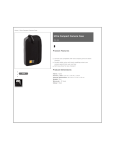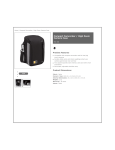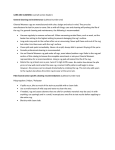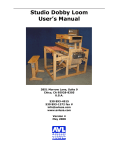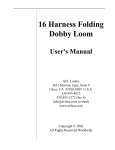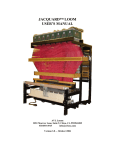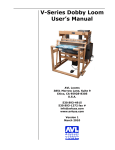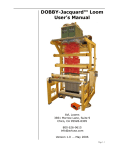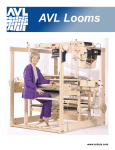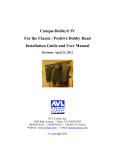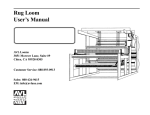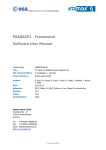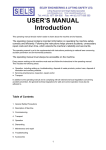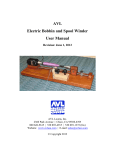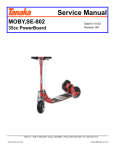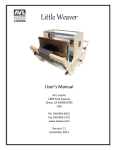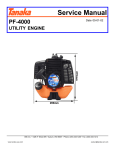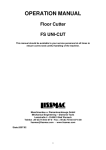Download Cover Page - AVL Looms
Transcript
INDUSTRIAL DOBBY LOOM User's Manual AVL Looms 3851 Morrow Lane, Suite 9 Chico, CA 95928-8305 U.S.A. 530 893-4915 530 893-1372 (fax #) [email protected] (e-mail) www.avlusa.com Copyright © 2002 All Rights Reserved Worldwide TABLE OF CONTENTS Parts List INTRODUCTION About this Manual PREPARATIONS Supplemental Loom Support 1.) Squaring 2.) Flexible Air Link 3.) Floor Brackets SAFETY TO START THE LOOM Pre-Op Checklist Controls 1.) Computer 2.) Manual Loom Control Automatic Loom Control USING PAUSE, STOP, EMERGENCY STOP RESTARTING AFTER AN "EMERGENCY STOP" Reversing Cloth Direction ADJUSTMENTS Compressor FR REGULATORS CYLINDER FLOW CONTROLS SYNCHRONIZED LOOM MOTION Automatic Cloth Advance Speed Adjustment Automatic Advance and Cloth Beam Gear Adjustment Dobby Cylinder Speed Adjustment Beater Speed Adjustment Cloth Storage Power Control CLOTH BEAM ROTATION ADJUSTMENT Adjusting Lever Sleeve Exchange PRESSURE ROLLER TEMPLE SYSTEM Setting the Temple Rollers Temple Rings WARP TENSION Set Tension Troubleshooting Tip SHUTTLE BOX ADJUSTMENT Backplate Tilt Backplate Cant Shuttle Box to Race Adjustment Box Timing 1 2 2 3 3 3 3 3 4 5 5 5 5 5 6 7 8 9 10 10 10 11 11 12 12 12 13 13 13 14 15 15 15 16 16 17 17 18 19 19 19 20 20 21 Page i TABLE OF CONTENTS MAINTENANCE Daily Weekly Monthly As Needed TROUBLE SHOOTING General Troubleshooting Tips Shuttle Doesn't Fire Shuttle Won't Stay On Race Shuttle Doesn't Box Completely Loom Fires On Empty Box Loom Stops -- Red Light On Loom Stops -- Green Light On Harnesses Drop or Don't Lift Automatic Cloth Advance Inoperable Inconsistent Pick Count Loose Shed Page ii 22 22 22 22 22 23 23 23 23 23 24 24 24 24 24 24 25 25 INDUSTRIAL DOBBY LOOM MANUAL PARTS LIST 1.) Harness Pulley Support 2.) 3.) Harness Pulleys (three sets) Dobby Cylinder 4.) 6.) Compu-Dobby Switch Box 7.) 8.) Dobby Head Top Horizontal 9.) 10.) Four-Box Shuttle Assembly Beater Top 11.) 12.) Reed Shuttle Race 13.) 14.) Beater Slide Rod Harnesses 15.) 16.) Castle Rear Vertical 18.) 19.) Beater Cylinder Assembly Front Vertical 20.) 22.) Middle Horizontal Cloth Storage Beam Support 25.) 26.) Spring Levers Bottom Horizontal 28.) 29.) Harness Springs Beater Slide Bracket 30.) 31.) Back Plate Lower Front 32.) 34.) Spring Lever Support Harness Cable Retainer 35.) 36.) Warp Beam Brake Drum Tension Arm Pulley 37.) 38.) Warp Beam (plain) Warp Beam Handle 40.) 41.) Separation Roller Warp Beam Retainer 42.) 43.) Upper Back Lower Back Page 1 INDUSTRIAL DOBBY LOOM MANUAL 44.) Cloth Storage Beam 45.) 46.) Cloth Beam Cloth Beam Gear 47.) 51.) Harness Cables Beater Slide Bearing 54.) 55.) Stop Collar Beater Assembly Mounting Bracket 56.) 57.) Beater Slide Bracket Beater Tube 59.) Rear Beater Shock Absorber Assembly INTRODUCTION Your Industrial Dobby Loom (IDL) is designed to be low-maintenance and immediately “user-friendly”. If you are an experienced power loom weaver, you may initially think this loom is a little quaint. If you’re more familiar with handlooms, it may seem impossibly busy and complicated. With a little hands-on experience, however, you’ll find that the IDL is “just right”. Considerable attention has been paid to the needs of the weaver. In addition to those things we know you’ll need, we’ve provided features that we think you’ll want. For example, the cloth beam can be removed so that you’ll have more working room when sleying the reed and we’ve placed the main operating controls conveniently “front-andcenter”. Feature for feature, you’ll soon discover that the IDL is the best loom in its class. About this Manual We know that most people have neither the time, nor the interest, in wading through pages of jargon-laden techarcania. We’ll not burden you with such here. However, there is certain amount of information that you will need, like how to turn the IDL “on”, how to make adjustments, and what you’ll need to do to keep your loom in top working condition. Wherever possible, we’ve provided you with “fast-track” explanations through processes. In most cases, more detailed information will be given in a side bar or information block. And we know that a picture is worth at least a thousand words, so you’ll have illustrations to guide you as well. Finally, you’ll find a Maintenance and Troubleshooting section in the back of the manual. Page 2 INDUSTRIAL DOBBY LOOM MANUAL PREPARATIONS Your IDL will have been assembled and tested before it left the factory. An AVL technician will, in most cases, have uncrated and installed the loom at your facility, run it, and made any necessary adjustments. It is also likely that someone on your staff will have been oriented to the loom. Supplemental Loom Support Depending on the circumstances of your particular installation, you may find it necessary to provide some additional support for your loom. 1.) Squaring In order for your loom to function properly, it must be level, front-to-back and side-to-side. To check front-to-back, place a carpenter’s level along the top of each Top Horizontal. Check side-to-side by placing the level along the length of the Cloth Beam and, again, along the Lower Back framing member. If you find that the loom is significantly out of level, you’ll need to either correct the floor or shim the legs of the loom. To square your loom, measure its diagonals, front to rear. These should be equal. 2.) Flexible Air Link If the air line from your compressor is made of a rigid material (steel pipe, pvc, copper), we suggest that you provide a flexible link between it and the loom. Simply connect a foot or more of 3/8” air hose between the FR and the end of the compressor line. This link will dampen vibration between your loom and the incoming air line, lessening the possibility of loosened fittings. 3.) Floor Brackets Your loom is equipped with special shock absorbing pads which will retard its tendency to “walk”. In some situations, the loom may need to be anchored to the floor. Brackets made for this purpose are available from AVL. If you opt to bolt your loom to the floor, be sure to first check its squareness. Page 3 INDUSTRIAL DOBBY LOOM MANUAL Bolting the loom to the floor will, overtime, reduce the need to readjust the squareness of the loom and the box adjustments. SAFETY Yes, we need to talk about safety. Any piece of equipment, from a hammer to a buzz saw, can be hazardous if it’s misused or misunderstood. The IDL is fitted with a variety of safety devices, but the critical element in using this machine safely is your good COMMON SENSE and ATTENTION TO THE RULES. And the rules are as follow: 1.) Never, under any circumstances, remove or disable one of your loom’s safety devices. 2.) Err on the side of caution: if something seems wrong, assume it is. Stop the loom until you’ve figured it out. 3.) Don’t take chances — be particularly careful about your hands. 4.) Disconnect both electrical power and air before you do any maintenance on your loom. 5.) Don’t guess. If you’re unsure about anything, and this manual doesn’t help, call our technical support number at 800 626-9615. 6.) Never stand at the end of the shuttle boxes when the loom is in motion. BE SAFE!!! You’ll come across other safety tips as you read more about your IDL. PLEASE, if you read nothing else in this manual, read this safety information! Page 4 INDUSTRIAL DOBBY LOOM MANUAL TO START THE LOOM Pre-Op Checklist Controls We advise that you first operate your loom with empty shuttles. This will give you an opportunity to study the action of the loom and will point up any operating deficiencies. But before you put the loom in motion: • Check that the shuttle boxes align with the shuttle race. • Check that the shuttle boxes traverse their support rods without rubbing or binding (move up and down by hand). • Check that the FR is set to operate at 105+ pounds of pressure. • Check that your compressor is rated to deliver at least 24 cubic feet of air per minute at 150 p.s.i. 1.) Computer Assuming that your computer is connected to the CompuDobby, and that you’ve loaded your software, make those menu selections that are appropriate for a plain weave; this provides a good test scenario. 2.) Manual Loom Control Assuming, as well, that your air line and power cord are connected: • Switch on the Compu-Dobby at the power center or front of the Compu-Dobby. • Set the AUTO/MANUAL control on the Control Box to MANUAL. • Load an empty shuttle into box #2 (push it all the way back against the picker). • Again, at the Control Box, turn the TURN ON/PUSH OFF button clockwise. The loom is now operational. Page 5 INDUSTRIAL DOBBY LOOM MANUAL • Using the hand control that connects to the Control Box, depress the ADVANCE button once: the Cloth Beam rotates a degree or so. • Depress the DOBBY button: the harnesses lift. • Depress the SHUTTLE button: the shuttle shoots. [repeat] • Depress the DOBBY button: the harnesses drop. • Depress the BEATER button: the beater advances. • Depress the BEATER: the beater returns. If any of the italicized actions did NOT occur, refer to the troubleshooting guide at the end of the manual. If the loom appears to be operating satisfactorily, proceed to Automatic Loom Control. Automatic Loom Control Automatic Loom Control means hands-free operation. Your loom will automatically cycle through it’s pre-programmed weaving plan; you’ll need only to load and replace bobbins as they empty. This will be your usual weaving mode, your production mode. BE SAFE!!! If you need to suddenly stop your loom at any time, push the EMERGENCY STOP on the Control Panel. However, if you use the EMERGENCY STOP, you’ll likely need to make an adjustment in your program. Remember: the EMERGENCY STOP will not allow the loom to proceed to the end of the current pick cycle, however, when you restart the loom, it will automatically move to the top of the next cycle (see “Restarting After an Emergency Stop” on page 8). Page 6 INDUSTRIAL DOBBY LOOM MANUAL 1.) Set the AUTO/MANUAL control on the Control Box to AUTO: the red light on is. CAUTION: The next step will put the loom in motion. Be sure that no one is standing at either end of the shuttle race and that all hands are clear of the front of the beater and other pinch points. USING PAUSE, STOP, EMERGENCY STOP 2.) Now, if you’re ready, press the green RUN button: the green light is on, the red light is off, the loom will cycle continuously. 3.) Hit the PAUSE button at any time to temporarily stop the loom: the green light is off, the yellow light is on, the loom stops. 4.) There are four practical ways to stop your loom: • Hit STOP • Hit PAUSE • Hit EMERGENCY STOP • Pull the plug In the end, each of these actions will bring the loom to a standstill; but, different situations call for different methods. Page 7 INDUSTRIAL DOBBY LOOM MANUAL STOP PAUSE EMERGENCY STOP PULL THE PLUG RESTARTING AFTER AN “EMERGENCY STOP” APPLICATION ACTION To stop the loom for any reason Loom works to the end of the cycle and stops To resume, press RUN No unintended effects To stop the loom when the shuttles don’t fully “box” Interrupts the loom, mid-cycle Press PAUSE to resume No unintended effects When you need to stop NOW Stops the loom immediately, mid-cycle Turn the loom on, Press Run Unintended Effect: The loom resets at the beginning of the next cycle, may result in a flaw in the fabric — discussion below When all else fails The boss comes running If you’ve used this mode, your loom will likely have stopped somewhere mid-cycle; that is, anywhere between a cloth advance and a beater return. However, when you re-start the loom, it will re-set automatically at the beginning of the next cycle. It will simply delete whatever weaving operations were yet to go when it was shut down. If you continue weaving in the AUTO mode, you’ll develop a flaw in the fabric. Solution: Page 8 1.) Switch the loom to Manual at the Control Panel. 2.) Determine where you are in the weaving sequence. INDUSTRIAL DOBBY LOOM MANUAL 3.) Use the hand control to advance through the remaining steps of the cycle. As a reminder, each cycle consists of the following sequence of steps: ADVANCE —> DOBBY —> SHUTTLE —> DOBBY —> BEATER —> BEATER 4.) Reversing Cloth Direction RETURN THE LOOM TO AUTO, PRESS RUN, AND CONTINUE. It sometimes happens that you’ll want to reverse the rotation of your cloth; you want to back-up. This is possible on your IDL, but it does require some extra effort and you’ll have to unwind the cloth by hand. 1.) Turn off the Cloth Storage/Regulator Switch at the left side of the loom. 2.) Lift the Tension Weight Arm to release tension on the warp. You'll want to see a piece of cord to secure the arm to the Upper Horizontal on the loom frame. 3.) Pull the pin at the Cloth Storage Beam to disconnect it from the drive hub. 4.) (See drawing.) Remove the spacer clip from the Automatic Advance drive shaft. Spacer Clip 5.) Disengage the Automatic Advance gear by pushing the axle end toward the center of the loom until the gears are unmeshed and the large washer touches the small bearing housing. Install the spacer clip between the large bearing housing and the gear (see drawing). Spacer Clip Page 9 INDUSTRIAL DOBBY LOOM MANUAL 6.) Back up the warp. 7.) Reverse the above steps to re-engage the Automatic Advance System. 8.) Adjust the warp tension. 9.) Run a few picks on MANUAL until the fell line has moved within approximately 6” of the reed. A hint here: you may want to disconnect the Auto Advance and comb in the first few picks by hand. 10.) Resume normal weaving in automatic mode. ADJUSTMENTS You’ll need to make certain adjustments to your loom in order to accommodate your changing weaving needs. Most of these adjustments are a matter of refining your preferences as you go or of changing the speed or force at which the loom’s mechanisms operate. There are, however, some minimum operating limits that must be adhered to for your IDL to function properly. Compressor Your compressor must be able to deliver a minimum of 24 cubic feet of air per minute at 150 pounds per square inch. FR (keep this set at 115 p.s.i.) The FR (Filter, Regulator) is mounted on the back of the Computer Cabinet. This is where the air line coming from the compressor connects to the loom. The primary function of this device is to meter the air pressure coming into the system. Air pressure is measured in pounds-per-square-inch (P.S.I.). If you’re not familiar with pneumatic systems, just think of air as you think of gas in your car. The more air, the more power. You’ll see a gauge on the FR and an adjustment knob immediately above it. Turn this knob clockwise to increase pressure. You should start pressure from the FR at 105+ p.s.i. The operating pressure is generally around 120 p.s.i. Page 10 INDUSTRIAL DOBBY LOOM MANUAL REGULATORS In addition to the FR, there are other regulators that meter the amount of air that is delivered to the different loom systems. These are located on the component board in the computer cabinet in the Component Box, to the left of the FR. Each regulator has a gauge and a yellow plastic locking ring. REMEMBER: regulators control power. FLOW CONTROLS, discussed below, control the speed at which your systems operate. Each regulator controls one system and is labeled on the air board in the computer cabinet. Consult the chart below to determine initial operating values for each system. You may find that these settings need to be modified, depending on the weight of your yarns, operating speed, and other factors. CYLINDER FLOW CONTROLS (Speed Controls) Regulator System P.S.I. Setting SV 1 SV 2 SV 3 SV 4 SV 5 Cloth Storage Beater Dobby Shuttle (right) Shuttle (left) 10-20 60 60 50 50 The speed at which each of the loom systems operates is regulated by “flow controls” located at various points on the loom: Cloth Advance: Harness Lifting: Box Changing: Cloth Storage: Automatic Advance Cylinder Dobby Cylinder Box Changing Cylinders Cloth Storage Cylinder These different systems will operate according to the choreography which you establish. You’ll want the loom to lift, beat, and pick according to your weaving needs at a particular moment. This means you’ll need to set the controls for each of the systems. It sounds much more complicated than it really is and, once you’ve made your initial setting, you won’t need to change them for the balance of your warp. Your installer will make the initial settings. Page 11 INDUSTRIAL DOBBY LOOM MANUAL SYNCHRONIZED LOOM MOTION Automatic Cloth Advance Speed Adjustment There is a particular order in which you’ll want to adjust each of the loom’s mechanisms. When you’ve finished, all the systems will work smoothly and in concert. We recommend that you proceed as follows: 1.) Automatic Cloth Advance 2.) Dobby 3.) Beater 4.) Box Changing 5.) Automatic Cloth Storage Be Safe!!! Put the loom in Manual mode when making any adjustments. This setting is made at the Automatic Advance Cylinder on the left side of your loom. Find the upper most cylinder, mounted just below the left beater cylinder. You’ll see that there are two plastic air tubes coming into the cylinder. At both connecting points, there is an adjusting screw. These are the flow controls. Use a small screwdriver to turn each screw in or out. Turn the screws counterclockwise to accelerate and clockwise to retard the action of the Automatic Cloth Advance. You’ll probably want to operate this system as quickly as possible. Automatic Advance and Cloth Beam Gear Adjustment Page 12 Flow Controls Sleeve Spacer To adjust the Automatic Advance and Cloth Beam Gear Mesh: 1.) Loosen the two bolts holding the left Fafnir VCJT1 bearing. 2.) Rolling the cloth toward you, feed a single piece of paper between the small Automatic Advance gear and the larger cloth beam gear, stopping when the paper is trapped between the gears. INDUSTRIAL DOBBY LOOM MANUAL Dobby Cylinder Speed Adjustment (controls harness lifting) 3.) Push down on the Cloth Beam to seat the gears into the paper. 4.) Retighten the VCJT1 bearing. 5.) Roll the Cloth Beam to check for binding between the gears (does not get harder to turn in one spot). If it does, then repeat the procedure with two pieces of paper and so on, until the beam rolls freely. The speed at which the harnesses are raised and lowered is controlled from the Dobby Cylinder. This is the large air cylinder that extends from the bottom of the dobby head on the right side of the loom. You set the flow controls on this cylinder in exactly the same way that you adjust those on the Automatic Advance Cylinder. Remember: clockwise retards, counterclockwise speeds. FO2A adjusts the harness in a downward movement FO2B adjusts the lifting speed The action of the harnesses needs to be coordinated with the action of the Automatic Advance. Beater Speed Adjustment Beater speed and force is a function of air pressure. Use the lowest measure setting needed to achieve a firm beat. Cloth Storage Power Control Note that we refer to power, not speed. The only thing you need be concerned about here is that the action of the Cloth Storage Cylinder is not greater than that of the Automatic Advance Cylinder directly above it. If the Storage Cylinder is set to overpower the Advance Cylinder, it will cause the warp to creep. To prevent this, set the regulator gauge at about 6 lbs.; just enough that the cloth storage mechanism keeps slack out of the cloth after it rounds the breast beam. Page 13 INDUSTRIAL DOBBY LOOM MANUAL CLOTH BEAM ROTATION ADJUSTMENT (to establish p.p.i.) The number of picks-per-inch that you’ll achieve is determined by the degree of rotation of the Cloth Beam. This is established, mechanically. Move to the left side of the loom. At the end of the Cloth Beam is a gear. This gear meshes with a second gear mounted below it. Connected to the bottom gear is a slotted lever. There are two ways to adjust your pick count: 1.) By increasing or decreasing the stroke of the adjusting lever. 2.) By exchanging one sleeve for another of a different size. PICK CHART Page 14 Sleeve Size Lever Position Picks Per Inch Small Sleeve #1 1 5/16 1 5/16 1 5/16 Top Middle Bottom 4 5 7 Small Sleeve #2 1 13/16 1 13/16 1 13/16 Top Middle Bottom 6 9 14 Small Sleeve #3 2 5/16 2 5/16 Middle 2 5/16 Bottom Top 20 30 16 Longest Sleeve #4 2 9/16 2 9/16 2 9/16 Bottom Top Middle 60 25 40 INDUSTRIAL DOBBY LOOM MANUAL These pick counts are approximations and are related to warp tension and by how hard the weft is beat into the warp. Increasing the warp tension and how hard you beat can increase the pick count. Adjusting Lever You’ll note that the Adjusting Lever is connected to the rod end of the Automatic Advance Cylinder by a locking T-handle. If you loosen this knob, you can move the rod end up or down in the slot. When you move the rod end up, the Cloth Beam rotates more and you have less picks per inch. Sleeve Exchange Your IDL is provided with four Automatic Advance sleeves. Each of these will cover a different pick range. The smaller the sleeve, the less picks per inch. PRESSURE ROLLER The Pressure Roller allows you to weave without using your Cloth Storage system. So you can cut off your work at any time without losing warp tension. To start: 1.) Pull the warp approximately 10" beyond the Cloth Beam. 2.) Push the Pressure Roller into the warp under the Cloth Beam until it snaps into place. 3.) To remove the roller, relieve tension (two knobs in front under the Cloth Beam), push the arm, and remove the roller. Page 15 INDUSTRIAL DOBBY LOOM MANUAL TEMPLE SYSTEM (to prevent draw-in) The Temple System is used to maintain a good selvage and prevent draw-in. You’ll usually deploy it after you’ve woven-off a yard or so of fabric, once you have selvage enough to work with. It consists of two rollers (barrels), working in tandem, which grab the selvage and prevent it from drawing in. This device looks complicated, but is, in fact, relatively easy to work with. Refer to the accompanying illustration and step-by-step instructions for guidance in using this system. Setting the Temple Rollers Page 16 • Check the routing of your fabric against the illustration. • Loosen the adjusting bolts on the Temple Holder Bracket so that it’s somewhat movable. • Swing the Temple Holder Bracket up and in, so that it is about 1/4” below the warp, with the selvage just touching the inside of the bracket. • Open the shed. • Bring the holder up until the ridges on its platform just contact the bottom of the warp. The platform should be parallel with the warp. • Tighten the Temple Holder Bracket adjusting bolt. INDUSTRIAL DOBBY LOOM MANUAL • Slide the leading roller (with the majority of the needled rings) into its slot on the Holder Bracket. Seat the roller atop the warp and lock it down with a hex key. • Install the after roller (with rubber grips). It bolts in. (optional) • Check to be sure that everything is properly tightened down. The selvages should run freely across the bracket. Using a Temple System is somewhat of an art and opinion varies amongst weavers about things like the choice of rings and the efficacy of the after roller. However, we can offer some useful guidelines to help get you started. Temple Rings We provide you will a set of general purpose rings. If your leading roller is holding the selvage sufficiently well, and isn’t causing looping or leaving a perforated line in the warp, you’re doing fine. If, however, you’re having problems, you made need to investigate different rings. As a rule of thumb, heavier yarns need rings with longer and fewer needles. Finer yarns require rings with more and shorter needles. For additional information, please contact an AVL Customer Service Representative. WARP TENSION The warp tension device on your loom offers a number of advantages; chief amongst these is that it allows you to set tension in extremely fine degrees that remain constant as your beam surrenders warp. Unless you’ve used other AVL equipment, you’re probably not familiar with this way of keeping tension. If you find the concept a little foreign, be patient; we promise that you’ll soon recognize its merit. Page 17 INDUSTRIAL DOBBY LOOM MANUAL Set Tension • Move the weight to its rearmost position, until it nearly touches the wooden pulley at the near end of the arm. • Advance the warp until the tension arm rises and the cable begins to slip on the brake drum (of the warp beam). • Ultimately, you’ll want the arm to ride horizontally. As you advance the warp, the arm should rise no more than 45º above horizontal and then fall back to horizontal. • If the arm is riding above horizontal, let the adjusting cord out at the spring. If it’s riding low, take up cord. • Check the tension in your warp. If it’s loose, move the weight out on the arm. Advance the warp a little and check again. Continue in this way until you have exactly the tension you want. Most weavers find that they can weave with less tension using this system. If you’ve laid on a very heavy warp, you may need to add weight to the arm. Additional weights can be obtained from AVL. Conversely, warps comprised of extremely fine yarns may require a lighter weight. AVL can provide you with a half-weight if you so desire. To make it a little easier to learn, we’ve created a quick reference for you to follow. You may want to copy it and keep it at the loom. Page 18 Arm above horizontal Arm below horizontal === === Release cord at the spring Take-up cord at the spring Warp too loose Warp too tight === === Move weight out Move weight in INDUSTRIAL DOBBY LOOM MANUAL Troubleshooting Tip The brake drum on the warp beam may, in areas or times of high humidity, swell a bit where the end grain is exposed. This swollen grain can prevent the tension cable from slipping as it should. When this happens, the tension arm will develop a habit of rising and then suddenly dropping. To correct this problem, unwind the brake cable and lightly sand the grain in the cable race of the drum. Use a very fine grade of sandpaper (220-400#) and sand as little as possible. Never, under any circumstances, should you apply a wax, or finish, or otherwise treat the cable race on the drum. SHUTTLE BOX ADJUSTMENT Backplate Tilt The shuttle boxes were adjusted when the loom was first installed at your site, however, over time, they may require some attention. You’ll know it’s time to check these adjustments if your usually tame shuttle seems suddenly to have become an “unguided missile”. There are three alignments essential to satisfactory loom operation: • Backplate tilt (downward angle) zero degree or very slight • Backplate cant (forward angle) zero degree or very slight • Shuttle box-to-race alignment - level or slightly higher (1/ 16" or less). Shelf cannot be lower than the race. The shuttle boxes must carry a slight downward angle relative to the shuttle race. This angle will cause the shuttle to “hug” the race as it travels across. If the boxes are misaligned in the opposite direction, the shuttle will take on an errant trajectory and may “porpoise” off the race — obviously creating an unsafe condition. Race Angle Exaggerated Page 19 INDUSTRIAL DOBBY LOOM MANUAL Backplate Cant The shuttle box assemblies must also carry a slight forward angle. In the same way that a bit of downward angle causes the shuttle to stick to the race, a slight forward canting of the backplates will keep the shuttle properly located against the reed as it travels across the loom. (Too much angle will cause the shuttle to bounce off of the reed and exit the loom area.) Race Box Shuttle Box to Race Alignment There are two critical alignments to consider here: 1.) The leading edge of each shelf in the Shuttle Box Assembly must be at precisely the same elevation as the top of the race (alignment “A” in the diagram below). You may check this by laying a straight edge between a box shelf and the race. Remember: the box assembly will be adjusted at a very slight to no angle, so its only the edge of the shelf, immediately opposite the end of the race, that concerns us here. This edge should be at the same height as the top of the race so that the shuttle can make a smooth entry into the Shuttle Box. Reed Shelf B Page 20 Race A INDUSTRIAL DOBBY LOOM MANUAL If the box shelves are lower or higher than the race, you’ll need to loosen the bolts in the large Box Mounting Bracket that attaches the Shuttle Box Assembly to the side of the loom. This will allow you to make the necessary adjustment. Binder Tensioners Bobbin Sensor Shuttle Retainer 3/4"-1" Shuttle Sensor Reflective Tape 2 1 3 #1 & #4 will speed/ slow the downward motion 2.) 4 #2 & #3 will speed/ slow the upward motion of box assembly The shelves in the box must be in the same plane as the race. If you sight down the end of the race, you’ll note that it’s cut on an angle. The angle of the shelves must correspond (alignment “B”). Again, if you need to correct this alignment, loosen the Box Mounting Bracket and move the box assembly into position. Box Timing It’s important that you get the timing of your boxes right. If a box moves too slowly, the picker will strike a shelf. If it moves too fast, the assembly will be subjected to constant jarring and possible damage. Because the action of the boxes needs to be synchronous, keep the up/down box speed equal. Page 21 INDUSTRIAL DOBBY LOOM MANUAL MAINTENANCE The Industrial Dobby Loom is designed to require very little maintenance. We suggest that you observe the following regime, however, you may find that your particular weaving environment requires that you do these things more or less often. Daily • Clean any lint away from the optical eyes and the CompuDobby. • Drain any moisture from the FR. • Check the oil level in the FR (if your unit requires lubrication). • Clean the Compu-Dobby filter (soap and water, air dry). • Check the loom frame bolts for tightness. • Lubricate the Shuttle Box Spring (with teflon spray, “TRIFLOW”, for example). • Clean and grease the Cloth Beam Axle (with any bearing grease). • Check the color on the dryer/filter at back of the computer cabinet. Replace the filter cartridge as recommended by the manufacturer. Weekly Monthly As Needed Page 22 INDUSTRIAL DOBBY LOOM MANUAL TROUBLE SHOOTING General You’ll probably find that most of the problems you encounter, at least until you’ve become familiar with the characteristics of the loom, involve shuttles. Each time you change from one yarn to another, you’ll need to fine tune the binders on the shuttle boxes and adjust the tensioners in the shuttles themselves. You may also need to change the pressure setting at Regulators SV 4 and 5. Very heavy yarns may require that you turn your shuttles around, so that the yarns feed out between the shuttle body and reed. This lessens the shuttle’s tendency to veer or yaw away. Poor air quality will produce an infinity of Gremlins. This can’t be stressed enough. Dirt, oil, and moisture in your air delivery system can clog and erode valves and other air components. Affected valves may operate sluggishly or not operate at all. Always use a clean air source. The shuttle boxes are fitted with various optical sensors. These are part of a larger “traffic control system” — not unlike a modern railway switching system — that prevents two shuttles from firing simultaneously. Keep these, and the reflectors opposite them, free of accumulated lint. If, for some reason, two shuttles do present at the same time, this system will shut the loom down: the shed will open slightly and the loom will abruptly turn off. Troubleshooting Tips Shuttle Doesn’t Fire 1.) 2.) 3.) 4.) Check for correct air pressure (105+ p.s.i.) Check that shuttle has boxed completely Shuttle sensor out of adjustment (see Adjustments section) More than one shuttle presenting: i.) A shuttle may have been placed in the wrong box ii.) A drafting error may have been made; check the program Shuttle Won’t Stay On Race 1.) 2.) 3.) 4.) Bobbin improperly wound Knot in weft catching on shuttle tensioner Bobbin nearly empty and out of balance Shuttle boxes need to be adjusted (see Adjustments) Page 23 INDUSTRIAL DOBBY LOOM MANUAL Shuttle Doesn’t Box Completely 1.) 2.) 3.) 4.) Insufficient air pressure Binder (shuttle brake) too tight Shuttle boxes need to be adjusted Knotted weft yarn may have hung in the tensioner and impeded shuttle travel; usually, but not always, it stops or derails shuttle Loom Fires On Empty Box 1.) Shuttle sensor out of adjustment (see Adjustments) Loom Stops — Red Light On 1.) 2.) Empty bobbin Two shuttles presenting (see Shuttle Doesn’t Fire above) Loom Stops — Green Light On 1.) 2.) 3.) Shuttle not boxed Sensors out of adjustment (see Adjustments) Automatic Advance cylinder too fast Harnesses Drop or Don’t Lift 1.) 2.) 3.) Compu-Dobby out of adjustment (see Adjustments) Harness springs too tight Auto Advance cylinder is over-powering dobby cylinder (see Adjustments) Dobby cable controlling errant harness is not engaging in the dobby finger inside the dobby head (poor Compu-Dobby adjustment) 4.) Automatic Cloth Advance Inoperable 1.) 2.) Page 24 Auto Advance lever is reversed; screws attaching the lever to the bearing housing should be visible Reed Switch is not properly located (see Reed Switch Location Diagram) INDUSTRIAL DOBBY LOOM MANUAL Inconsistent Pick Count 1.) 2.) 3.) 4.) 5.) 6.) 7.) 8.) 9.) Loose Shed 1.) 2.) Cloth Storage system not on Pressure setting too low or too high at the Cloth Storage regulator T-handle on the Automatic Cloth Advance lever is loose Fluctuations in the air delivery — compressor problem Check the cable at the Tension Arm — it may be crossed If the tension is loosening, the black plastic cord lock on the tension tie-up (in the Tension Arm cable) may be slipping; re-set the tension and tie-off with a piece of cord Loose the screw on the Right Vertical Cap (which holds the Cloth Beam Anti-Rollback Bearing) Beater pressure not correct for particular yarns being woven Cloth Beam Gear not properly meshing with the Automatic Advance Gear; gear mount bracket loose Cloth Storage System not turned on Exceeding pick count possible with yarn being woven; this is especially a problem with thick yarns at high pick counts Page 25




























